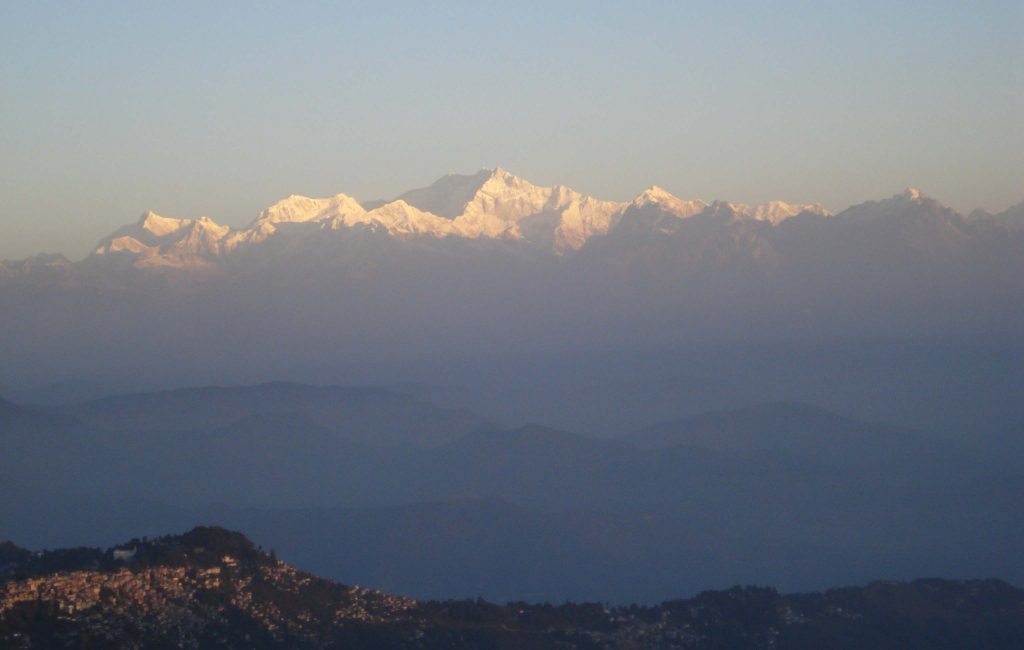There are so many things to do in Darjeeling, yet you can make the most of your stay by just lazing on a bench and gazing at the magnificent Kanchenjunga. That’s the captivating beauty of Darjeeling. And so magnetic is the appeal of this small hill station that you would want to go back to this place again and again.
The ideal time to visit Darjeeling is between February and May and September to November. But if you are adventurous, December and January are more exciting. However, we planned our trip in October hoping to get the best view of the Kanchenjunga, as the sky generally remains clear after the monsoon at this time of the year.
Siliguri is the gateway to Darjeeling and is well connected by rail, road and air. Three nights are ideal for Darjeeling, but if you want to explore more, you could extend the trip by one more day. We took an early morning flight to Bagdogra airport. It’s always advisable to reach Siliguri early and start for Darjeeling to make the most of the drive up to the hills.
There are many trains that reach New Jalpaiguri in the morning. Finding a car isn’t much of a problem. However, do try for a bargain. A one-way drive up to Darjeeling in a hatchback costs around Rs 1,800 to Rs 2,000.
We started from the airport around 9 am. Twenty minutes later, leaving behind the hustle and bustle of the town we were on the narrow road through Rohini. There are three routes to reach Darjeeling from Siliguri. However, it is best to go via Rohini and drive down Pankhabari Road to make the return journey equally exciting.

Rohini is also the shortest route and a two-and-a-half-hour drive will get you to Darjeeling. October is humid in Siliguri but as we drove on, we could feel the change in the weather. There was a slight nip in the air, and we could see the clouds moving at almost eye-level, as our car drove up the meandering roads.
Slowly, the tea gardens started appearing on either side of the hills. The sun playing hide and seek with the clouds, the occasional drizzle, and the changing colour of the tea gardens — it’s all very picturesque. After an hour’s drive, we reached Kurseong, home to some of the finest residential schools in the country. On our way out of the town, we decided to halt at Kurseong Tourist Lodge.
This wooden-structured British-era lodge stands on a cliff and has an amazing view of the tea gardens. You can soak in the serene beauty through the windows over a plate of hot momos and chicken sandwich accompanied by steaming hot Darjeeling tea.
Breakfast done, we headed for Darjeeling. Another hour’s drive and crossing some of the most iconic British-era tea estates like Margaret’s Hope, we reached Darjeeling via Ghoom. There are more than a hundred hotels in Darjeeling, with a few star properties. The best thing to do is to put up at a heritage hotel that provides a clear view of the Kanchenjunga.

Much like most of the north east and northern Himalayas, Darjeeling too has a colonial hangover. But that’s perhaps the best thing about this place. A quick lunch and rest later, we decided to take a walk on Chowrasta or Darjeeling Mall, the public square. Located in the heart of the town, this has been an assembly point for residents and visitors since the 19th century.
You can simply sit on a bench and watch the sunset or drop into one of the many tea parlours. As we didn’t have plans for the evening, we decided to take a walk along the Observatory Hill and Mahakal Temple. If you are in a mood to explore local cuisine, drop in at any of the food joints and try out the thupka.
Lepchas are the original residents of Darjeeling. Most of them are Gorkhas, who are Nepali immigrants, while there is also a huge population of Sherpas and Bengalis. The best place to have thupka is Kunga restaurant. It’s a small eatery but serves delectable thukpa in the most traditional way.
Next day, we decided to go for breakfast to Keventer’s. If you want a sumptuous breakfast or an afternoon tea, then Keventer’s is the place to be. The century-old eatery, located diagonally opposite the iconic Planter’s Club, is known for its English breakfast. From the rooftop, you can enjoy a view of the Kanchenjunga with the sun lighting up the peak even as you tuck in to a lavish breakfast comprising poached eggs, meat loaf, sausages, sandwiches, chocolate shake and aromatic Darjeeling tea.

There are so many places to visit in Darjeeling, with the Rock Garden having gained prominence in the last few years. However, there are also a few places that tourists often give a miss.
We decided to start with a visit to a tea garden. Although it cannot be described as tea tourism, a trip to Darjeeling is incomplete without a visit to a tea garden.
After a short halt at a tea garden, we headed for the ropeway. Also known as the Rangeet Valley Cable Car, it is the largest ropeway in Asia. Riding in the cable car is an experience of a lifetime, as you get a panoramic view of the many tea gardens and the lush green valleys. In fact, you actually pass through clouds while riding the cable car.
Our next stop was the Padmaja Naidu Himalayan Zoological Park. Home to snow leopards, Himalayan wolves, red pandas and yaks, you can also spot a large number of rhododendron bushes. A must-visit place is the Himalayan Mountaineering Institute (HMI). A place of pilgrimage for climbing enthusiasts, the institute was established to honour the feat of Sir Edmund Hillary and Tenzing Norgay after they conquered the Everest in 1953. One of the biggest attractions is the museum which houses memorabilia and gears of some of the most prominent mountaineers of the world, including Norgay and Hillary.
Children can try their hand at rock climbing on the Tenzing Rock, under the guidance of students from the HMI. Our next stop was the less-popular Tibetan Refugee Centre. On your way to the refugee centre, you will cross two prominent educational institutions, St Paul’s School and St Joseph’s College, that have often lured Hindi filmmakers. From Mera Naam Joker, Do Anjane to Main Hoon Na and Barfi, many a Bollywood classic has been shot on the premises of these two institutions.
The Tibetan Refugee Centre is a downhill drive from the main town. When the Dalai Lama crossed over to India, a number of his followers accompanied him. Many among them were given shelter in this refugee centre and their families continue to live there. Don’t miss the Tibetan Handicraft Centre where you can shop for some stunning room decor products and woollens at affordable prices.
We planned to have lunch at the hotel and reserved the evening for a drink at the popular Joey’s Pub, the nucleus of Darjeeling nightlife. The old British-style country pub with a small front porch and triangular roof and wood panelled interiors has been in operation since 1948. Originally made to lodge backpackers, even today the pub bustles with foreigners. If you love music, then an evening at Joey’s Pub over a mug of beer is a must.
The next morning, we planned to take a toy train ride. However, before that we wanted to see the sunrise. You can pre-book a car from the hotel, which will take you to Tiger Hill around 3.30 in the morning. Given the chill, it’s a shade tough to wake up so early in the morning but you won’t regret that.
Tiger Hill is 11 kilometres from the main town and is the ideal place to watch the sun illuminating the peak of the colossal Kanchenjunga and Mt Everest.
Back in the hotel and after a quick breakfast, we headed for Darjeeling railway station. Operating on narrow gauge from Siliguri to Darjeeling since 1880, the train services are now available only between Darjeeling and Ghoom. It is best to pre-book tickets. There are both steam engines and diesel engines, with the former always a better option.
Accorded UNESCO World Heritage status, the two-coach train passes through mist-shrouded forests and takes you to the famous Batasia Loop, a five-kilometre-long loop around which the train completes a steep full circle. The train stops for 10 minutes and you can get down, click photographs and visit the War Memorial built in the honour of Gorkha soldiers. The train’s final halt is at Ghoom station. A 30-minute halt gives you a chance to visit the adjoining railway museum and the Ghoom Monastery.
A round trip to Ghoom takes around 90 minutes and we were back in Darjeeling for lunch. This was our last full day in Darjeeling, and we had planned to have both our lunch and dinner at the Glenary’s, the iconic bakery and restaurant. The bakery and coffee shop is located on the ground floor of a two-storied colonial building. The restaurant, which gives a panoramic view of the Kanchenjunga, serves some delicious continental dishes. The mixed steak is a must-have, while the lemon tart, apple pie and chocolate cookies at the bakery will leave you asking for more.
The Glenary’s also offers great Chinese cuisine, which we had for dinner. The plan was to start for Siliguri next day post lunch. In the morning, we decided to explore the shops and pick up some knick-knacks. There are several curio shops around Chowrasta and you can pick up some hand-crafted bone china crockery and wall hangings.
After lunch, we headed for Bagdogra. The obvious choice was to take the Pankhabari Road. It is an amazing experience driving down this steep meandering road. On your way down, you will cross two famous tea estates — Makaibari and Castleton. This road has seven steep consecutive hairpin turns which will give you goosebumps, but it’s worth experiencing. Two hours later, we were at Bagdogra to board our flight but, in the meanwhile, we had already started planning our next visit.
RITUJAAY GHOSH, OP







































